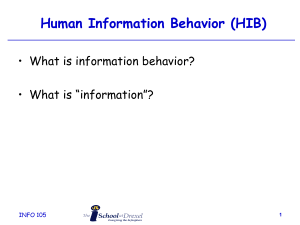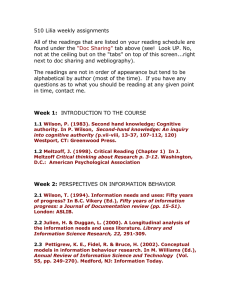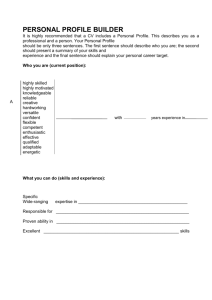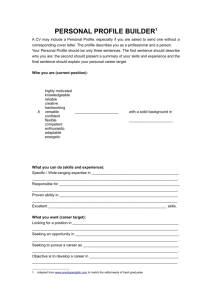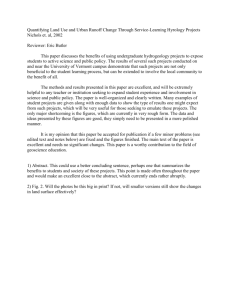612 06 Bibliography.doc
advertisement
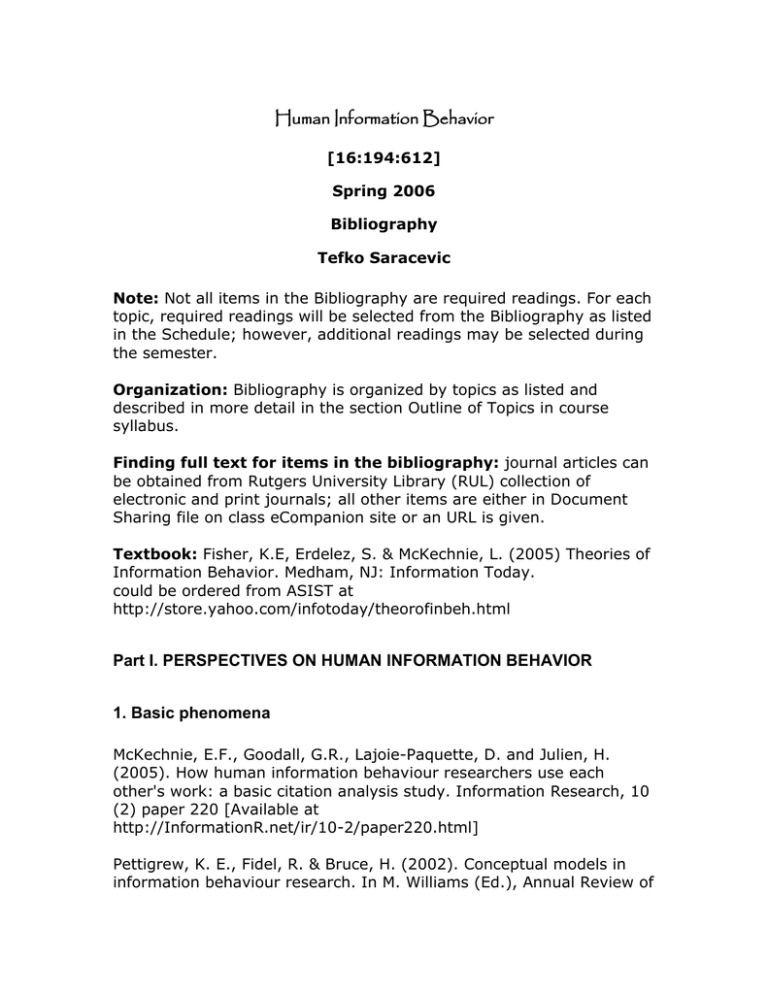
Human Information Behavior [16:194:612] Spring 2006 Bibliography Tefko Saracevic Note: Not all items in the Bibliography are required readings. For each topic, required readings will be selected from the Bibliography as listed in the Schedule; however, additional readings may be selected during the semester. Organization: Bibliography is organized by topics as listed and described in more detail in the section Outline of Topics in course syllabus. Finding full text for items in the bibliography: journal articles can be obtained from Rutgers University Library (RUL) collection of electronic and print journals; all other items are either in Document Sharing file on class eCompanion site or an URL is given. Textbook: Fisher, K.E, Erdelez, S. & McKechnie, L. (2005) Theories of Information Behavior. Medham, NJ: Information Today. could be ordered from ASIST at http://store.yahoo.com/infotoday/theorofinbeh.html Part I. PERSPECTIVES ON HUMAN INFORMATION BEHAVIOR 1. Basic phenomena McKechnie, E.F., Goodall, G.R., Lajoie-Paquette, D. and Julien, H. (2005). How human information behaviour researchers use each other's work: a basic citation analysis study. Information Research, 10 (2) paper 220 [Available at http://InformationR.net/ir/10-2/paper220.html] Pettigrew, K. E., Fidel, R. & Bruce, H. (2002). Conceptual models in information behaviour research. In M. Williams (Ed.), Annual Review of Information Science and Technology, 37, 249-270. Medford, NJ: Information Today. Wilson, T.D. (1997). Information behavior: an interdisciplinary perspective. Information Processing & Management, 33 (4), 551-572. Wilson, T.D. (2000). Human Information Behavior. Informing Science, 3 (2), 49-56. 2. Problems addressed over time Case, D.O. (2006). Information behavior.In; Cronin, B, (Ed.) Annual Review of Information Science and Technology 40, 297-327 . Medford, NJ: Information Today. Dervin, B., & Nilan, M. (1986). Information needs and uses. In M. E. Williams (Ed.), Annual Review of Information Science and Technology 21, 3-33. White Plains, NY: Knowledge Industry Publs. Julien, H. & Duggan, L. (2000). A Longitudinal analysis of the information needs and uses literature. Library and Information Science Research, 22 (2), 291-309. Pettigrew, K.E., Fidel, R. & Bruce, H. (2001) Conceptual frameworks in information behavior. In M. E. Williams (Ed.), Annual Review of Information Science and Technology 35, 43-78. Medford, NJ: Information Today. Wilson, T.D. (1994). Information needs and uses: fifty years of progress, in: B.C. Vickery, (Ed.), Fifty years of information progress: a Journal of Documentation review, (pp. 15- 51) London: Aslib. [Available at http://informationr.net/tdw/publ/papers/1994FiftyYears.html] Part II. THEORETICAL STRUCTURES 3. Key theoretical concepts Dervin, B. (1992). From the mind's eye of the user: The sense-making qualitative-quantitative methodology. In Glazier, J.D. & Powell, RR. Qualitative research in information management (pp. 61-84). Englewood, CO: Libraries Unlimited. Kuhlthau, C. C. (1993). A principle of uncertainty for information seeking. Journal of Documentation, 49 (4), 339-355. Talja, S., Keso, H. & Peitilainen, T. (1999). The production of 'context' in information seeking research: A metatheoretical view. Information Processing & Management, 35 (6), 751-763. Wilson, P. (1983). Second hand knowledge; Cognitive authority. In P. Wilson, Second-hand knowledge: An inquiry into cognitive authority (p.vii-viii, 13-37, 107-112, 120) Westport, CT: Greenwood Press. 4. Theories on why people seek information Belkin, N.J., Oddy, R.N. & Brooks, H.M. (1982) ASK for information retrieval. Part I: Background and theory. Journal of Documentation, 38 (2), 61-71. Belkin, N.J. (1980). Anomalous states of knowledge as a basis for information retrieval. Canadian Journal of Information Science, 133143. Byström, K, & Järvelin, K.. (1995). Task complexity affects information seeking and use. Information Processing & Management, 31 (2), 191213. 5. Theories involving broader constructs Savolainen, R. (1993). The sense-making theory: reviewing the interests of a user-centered approach to information seeking and use. Information Processing & Management, 29 (1), 13-28. Taylor, R. S. (1968). Question negotiation and information seeking in libraries. College & Research Libraries, 28, 178-194. Talja, S. (1997). Constituting 'information' and 'user' as research objects: A theory of knowledge formations as an alternative to the 'information man' theory. In P. Vakkari, R. Savolainen, & B. Dervin (Eds.), Information seeking in context (pp. 67-80). London: TaylorGraham. Tuominen, D. & Savolainen, R. (1999). A social constructionist approach to the study of information use as discursive action. In P. Vakkari, R. Savolainen, & B. Dervin (Eds.), Information seeking in context (pp. 81-96). London: Taylor-Graham. Part III. INFORMATION SEEKING AND SEARCHING 6. Information seeking models Järvelin, K. & Ingwersen, P. (2004). Information seeking research needs extension towards tasks and technology. Information Research, 10 (1) paper 212 [Available at http://InformationR.net/ir/101/paper212.html] Wilson, T.D. (1999). Models in information behaviour research. Journal of Documentation, 55 (3), 249-270. 7. Models and empirical studies on how people search for information Bates, M. (1989). The design of browsing and berrypicking techniques for the online search interface. Online Review, 13 (5), 407-424. Greenberg, J. (2004). User comprehension and searching with information retrieval thesauri. Cataloging & Classification Quarterly, 37 (3), 103-120. Kuhlthau, C. (1991). Inside the Search Process: Information Seeking.from the User’s Perspective. Journal of the American Society for Information Science, 42 (6), 361-371. Schacter, J., Chung, G. & Dorr, A. (1998). Children's Internet searching on complex problems: performance and process analyses. Journal of the American Society for Information Science and Technology, 49 (9), 840-849. Spink, A., Park, , M. & Jansen, B. J. & Pedersen, J. (2006). Multitasking during Web search sessions Information Processing & Management, 42 (1), 264-275. 8. Studies in human-computer interaction, relevance Hert, C. A. (1997). Understanding information retrieval interactions: theoretical and practical implications. Greenwich CT: Ablex. Chapter 1: Setting the stage for a new understanding of information retrieval interaction and Chapter 2: What do we know about user behavior in information retrieval systems? (pp. 1-50). Saracevic, T. (in press). Relevance: A Review of the Literature and a Framework for Thinking on the Notion in Information Science. Part II. Advances in Libraianship. Part IV. STUDIES OF HUMAN INFORMATION BEHAVIOR CONTEXTS 9. Human information behavior in science, technology, medicine and health Anderson, C., Glassman, M., McAfee, R., & Pinelli, T. (2001). An investigation of factors affecting how engineers and scientists seek information. Journal of Engineering and Technology Management, 18 (2), 131-155. Brown, C.M. (1999). Information seeking behavior of scientists in the electronic information age: Astronomers, chemists, mathematicians, and physicists. Journal of the American Society for Information Science, 50 (10), 929-943. Ellis, D., Cox, D. & Hall, K. (1993). A comparison of the information seeking patterns of researchers in the physical and social sciences. Journal of Documentation, 49 (4), 356-369. Eysenbach, G., & Kohler, C. (2002, March 9). How do consumers search for and appraise health information on the world wide web? British Medical Journal, 324 (7337), 573-577. Gorman, P.N. (1995). Information needs of physicians. Journal of the American Society for Information Science, 46 (10), 729-736. Jones, P.H. (2005). Information practices and cognitive artifacts in scientific research. Cognition, Technology and Work, 7 (2), 88-100 . Liaw, S.-S., Chang, W.-C., Hung, W.-H. & Huang, H.-M. (2006). Attitudes toward search engines as a learning assisted tool: Approach of Liaw and Huang's research model. Computers in Human Behavior,22(2), 177-190. Pettigrew, K. E. (1999). Waiting for chiropody: contextual results from an ethnographic study of the information behaviour among attendees at community clinics. Information Processing and Management, 35, (6), 801-817. Rutten L.J.F., Arora N.K., Bakos A.D., Aziz N. & Rowland J. (2005). Information needs and sources of information among cancer patients: a systematic review of research (1980-2003). Patient Education And Counseling 57 (3), 250-261. 10. Human information behavior in professions and government Dilevko, J. (2000). "My mother can't quite understand why I decided to go to library school:" What patrons say about library staff when asking government documents reference questions at depository libraries. Journal of Government Information, 27 (3), 299-323. Kuhlthau, C. C. & Tama, S. L. (2001). Information search process of lawyers: A call for 'just for me' information services. Journal of Documentation, 57 (1), 25-43. Leckie, G. J., Pettigrew, K.E., & Sylvain, C. (1996). Modeling the information seeking of professionals: a general model derived from research on engineers, health care professionals, and lawyers. Library Quarterly, 66 (2), 161-193. 11. Human information behavior in arts, humanities, and education Bates, M. J., Wilde, D.N., & Siegfried, S.L. (1993). An analysis of search terminology used by humanists: the Getty Online Search Project report number 1. Library Quarterly, 63 (1), 1-39. Case, D. O. (1991). Conceptual organization and retrieval of text by historians: The role of memory and metaphor. Journal of the American Society for Information Science, 42 (9)672-689. de Tiratel, S. R. (2000). Accessing information use by humanists and social scientists: A study at the Universidad de Buenos Aires, Argentina. The Journal of Academic Librarianship, 26, (5), 346-354. Stefl-Mabry, J. (2005) The reality of media preferences: Do professional groups vary in awareness? Journal of the American Society for Information Science and Technology,56 (13), 1419-1426. Zach, L. (2005). When is "enough" enough? Modeling the informationseeking and stopping behavior of senior arts administrators. Journal of the American Society for Information Science and Technology,56 (1), 23-35. Part V. HUMAN INFORMATION BEHAVIOR IN EVERYDAY LIFE AND SOCIETY 12. Use of information resources and information in variety of social contexts Agosto, D.E. & Hughes-Hassell, S. (2005). People, places, and questions: An investigation of the everyday life information-seeking behaviors of urban young adults. Library & Information Science Research 27 (12), 141–163. Chatman, E.A. (1996). The impoverished life-world of outsiders. Journal of the American Society for Information Science and Technology, 47 (3), 193-206. Harris, R.M. & Dewdney, P. (1994). Barriers to information. How formal help systems fail battered women. Westport, CN: Greenwood. Chapters 4 & 8: pp. 47-60, 121-140 Savolainen, R. (1995). Everyday life information seeking: approaching information seeking in the context of 'Way of Life.' Library and Information Science Research, 17 (3), 259-294. Spink, A. & Currier, J.(2006) Towards an evolutionary perspective for human information behavior: An exploratory study. Journal of Documentation, 62(2), 171-193. Todd, R. J. (1999). Utilization of heroin information by adolescent girls in Australia: A cognitive analysis. Journal of the American Society for Information Science, 50, (1), 10-23. 13. Characteristics and requirements of information society Kruger, H. (2005) I, librarian. Information Technology and Libraries 24 (3), pp. 123-129 Sawyer, S. & Rosenbaum, H. (2000). Social Informatics in the Information Sciences: Current Activities and Emerging Directions. Informing Science, 3 (2),89-96. ______________________________________________ last update 13 April 2006 Tefko Saracevic
